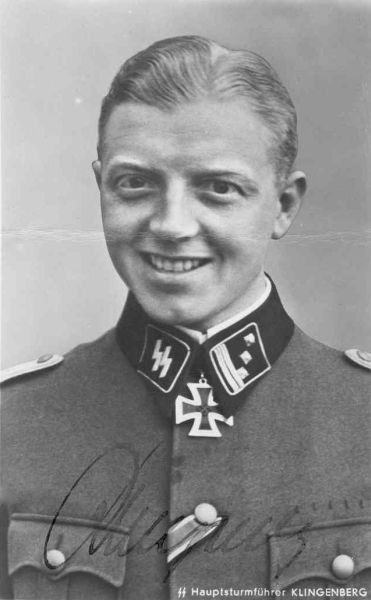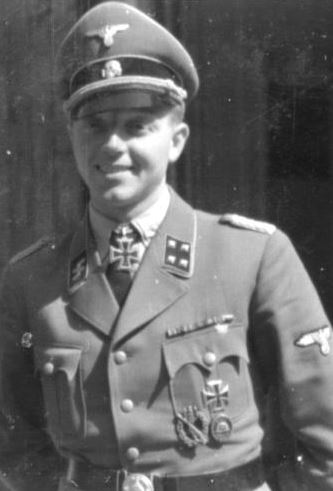Klingenberg, Fritz 'Fritzy' (Waffen SS)
- Date of birth:
- December 17th, 1912 (Rövershagen/Mecklenburg, Germany)
- Date of death:
- March 22nd, 1945 (Herxheim/Palatinate, Germany)
- Buried on:
- German War Cemetery Andilly
Plot: 35`. Row: 10. Grave: 731. - Service number:
- SS-Nr.: 51.487 // NSDAP-Nr.: 851.328
- Nationality:
- German
Biography
SS-Standartenführer Fritz Paul Heinrich Otto Klingenberg
Promotions:
14.11.1932: SS-Anwärter
00.00.1933: SS-Mann
01.04.1934: SS-Junker
20.12.1934: SS-Hauptscharführer
20.04.1935: SS-Untersturmführer
12.12.1937: SS-Obersturmführer
30.06.1939: SS-Hauptsturmführer
01.09.1941: SS-Sturmbannführer
21.12.1943: SS-Obersturmbannführer
21.12.1944: SS-Standartenführer
00.04.1945: SS-Oberführer (uncertain but surely posthumously)
Fritz Klingenberg was born on 17th December 1912 in Rövershagen, Germany. He joined the SS-Verfügungstruppe in 1934. In 1935 he graduated from the SS-Junker-Schule in Bad Tölz and was promoted to SS-Untersturmführer. His first assignment was with the SS-Standarte "Germania" where he was a Kompanie-Führer. After this he was assigned to the staff of the "Inspektor der SS-Verfügungstruppe". In the battle for France in June 1940 he was Kompanie-Führer in the SS-Division "Reich". Subsequently he was involved in the fightings at the Balkan. He stayed in command of a Kradschützen-Bataillon until 1942, after which he was assigned to the staff of the SS-Junker-Schule "Bad Tölz", as commander of a group of officer recruits. In January 1945 he became Kommandeur of the 17.SS-Panzergrenadier-Division "Götz von Berlichingen". He was killed on 22 March 1945, not far from Herxheim in the Palatinate.
Do you have more information about this person? Inform us!
- Rank:
- SS-Obersturmführer (Lieutenant)
- Unit:
- Stab, Inspektion, SS-Verfügungstruppe
- Awarded on:
- 1939
- Rank:
- SS-Obersturmführer (Lieutenant)
- Unit:
- Stab, Inspektion, SS-Verfügungstruppe
- Awarded on:
- 1939
- Period:
- Second World War (1939-1945)
- Rank:
- SS-Hauptsturmführer (Captain)
- Unit:
- Adjutant, SS-Verfügungsdivision
- Awarded on:
- June 23rd, 1940
- Period:
- Second World War (1939-1945)
- Rank:
- SS-Hauptsturmführer (Captain)
- Unit:
- Adjutant, SS-Verfügungsdivision
- Awarded on:
- June 24th, 1940
- Period:
- Second World War (1939-1945)
- Rank:
- SS-Hauptsturmführer (Captain)
- Awarded on:
- April 13th, 1941
- Period:
- Second World War (1939-1945)
- Rank:
- SS-Hauptsturmführer (Captain)
- Unit:
- Chef, 2. Kompanie, SS-Kradschützen-Bataillon 'Reich', SS-Division 'Reich', XXXXI. Armeekorps, 12. Armee
- Awarded on:
- May 14th, 1941
“On the 12.04.1941 SS-Hauptsturmführer Klingenberg had the mission of capturing the Danube bridge north of Belgrade in a coup-de-main with his small forward detachment of the Kradschützen-Bataillon.
At 08:00 on this day Hauptsturmführer Klingenberg reached Pancevo, but found that the bridge over the Tamis river had been blown. He crossed over with fishing boats while taking along a few solo motorcycles. Riding on these, he and his small troop reached the great Danube bridge north of Belgrade at 11:30. The bridge had already been blown at 06:00 that morning. By 15:30 SS-Hauptsturmführer Klingenberg had made a motorboat operational, and he crossed over the Danube on this boat with 10 men, 2 MGs and 5 machine-pistols. Along the way the boat ran aground on a sandbank and it was made afloat again following laborious effort. Then the engine stopped, and the boat almost crashed against a bridge buttress. After the motor was restarted Hauptsturmführer Klingenberg reached the southern end of the great bridge at around 16:30.
He created a small bridgehead and sent the boat back to pick up additional troops. Then he personally began marching on foot into the inner part of Belgrade with 10 men. Oncoming Serbian soldiers were persuaded to lay down their weapons with friendly shots.
Riding on several military vehicles which had been taken from Serbian soldiers, Hauptsturmführer Klingenberg proceeded to the war ministry. As the ministry was destroyed and empty, security was established around it. Hauptsturmführer Klingenberg then sent out a Serbian soldier as a messenger in order to find and immediately summon the mayor of Belgrade for the surrender of the city.
In the meantime Hauptsturmführer Klingenberg and a few of his men went to the German embassy. There they met the German military attaché, Oberst Toussaint, and raised the German flag. He brought over the security detail that was by the embassy and awaited the mayor.
He appeared at the German embassy and formally surrendered the city of Belgrade at 18:45, being under the impression that stronger German units had occupied the city.
In order to simulate stronger forces, Hauptsturmführer Klingenberg and his now reinforced troop drove through the city in vehicles and opened fire on all Serbian soldiers encountered. In addition to numerous smaller detachments that immediately laid down their arms and surrendered, he also went up against stronger formations. An engineer column along with other units were persuaded into laying down their weapons by friendly fire. About 1000 prisoners were taken.
Hauptsturmführer Klingenberg then occupied and secured the German embassy until the arrival of other German units, which reached Belgrade during the night.
Thus Hauptsturmführer Klingenberg completed his mission of capturing the bridge and with it a bridgehead on the southern bank, a task that he carried out while responding flexibly to changing circumstances. Furthermore he made the independent decision to force the surrender of Belgrade, and was ultimately able to bring about this intention with only weak forces and while under challenging circumstances.”
- Period:
- Second World War (1939-1945)
- Rank:
- SS-Hauptsturmführer (Captain)
- Awarded on:
- July 3rd, 1941
- Period:
- Second World War (1939-1945)
- Rank:
- SS-Sturmbannführer (Major)
- Awarded on:
- October 19th, 1941
- Period:
- Second World War (1939-1945)
- Rank:
- SS-Sturmbannführer (Major)
- Awarded on:
- November 3rd, 1942
- Period:
- Second World War (1939-1945)
- Rank:
- SS-Sturmbannführer (Major)
- Unit:
- Kdr, II. Abteilung, SS-Panzer-Regiment 2, 2. SS-Panzer-Division 'Das Reich'
- Awarded on:
- August 1943
- Period:
- Second World War (1939-1945)
- Rank:
- SS-Obersturmbannführer (Lieutenant-colonel)
- Unit:
- Führer, II. Abteilung, SS-Panzer-Regiment 2, 2. SS-Panzer-Division 'Das Reich', Waffen-SS
- Awarded on:
- April 28th, 1944
Sources
- Photo 1: Willi Schumacher Collection
- Photo 2:
- - FELLGIEBEL, W.P., Elite of theThird Reich, Helion & Company Limited, Solihull, 2003.
- MOONEY, PETER, Waffen-SS Knights and their Battles, Schiffer Pub Ltd, 2008.
- PATZWALL, K. & SCHERZER, V., Das Deutsche Kreuz 1941-1945, Band II, Verlag Klaus D. Patzwall, Norderstedt, 2001.
- Die Ordensträger der Deutschen Wehrmacht (CD), VMD-Verlag GmbH, Osnabrück, 2002
- Fritz Paul Heinr.Otto Klingenberg | Gräbersuche-Online
-- Microfilm Publication A3343. US National Archives























